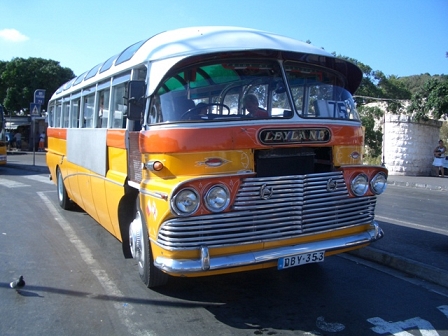Erstellt am: 3. 7. 2011 - 16:09 Uhr
A Rusty Grave For a Mediterranean Icon
A bus ride across the entire length of the EU member state Malta, from the capital Valletta in the South to the Cirkewwa Ferry Terminal in the North used to be a real travel adventure. Admittedly the main island is only around 17 kilometers long, so the journey can hardly be compared with the Cairo to Cape Town route, but on one of those vintage canary yellow buses, usually several decades old, which rattled with minimal suspension over pot-holed roads, it still felt epic. The trip would take around two hours and left you with the impression that, while still in Europe, you’d done something intrepid.

chris cummins
The seats were often clumsily welded on the floor and were bum-numbingly uncomfortable. All the windows had to be kept open to keep the stifling heat out and a wind blew through the bus that could blow your hat off. When the bus would stop (and it stopped every few minutes on an island in a state of almost permanent grid lock) the flow of wind would cease, the sun would beat down on the metal roof and you would start sweating again.
It was an awful way to travel, but like riding those noble but rusted Cuban taxis still surviving from the pre-Revolution 1950s, it was an awfully fun way to travel.
As of today such journeys are a thing of the past. The 3rd of July marks the day that a modern fleet of identical buses will make travel in Malta much easier, much faster, vastly more environmentally friendly, but lacking in charisma.
It is the end of an era for the traditional public transport system. The old buses were privately owned, often passed from generation to generation, sometimes driven by the father and worked on, welded and tinkered with by the sons. The family would apply for a license, be assigned a route and then pick up customers at a fountain just outside Valletta’s walled city called Funtana tat-Tritoni (the Maltese language is Arabic in origin). The buses were often converted out of old army trucks and looked wildly different and, just like the tro-tro minibuses I used to ride in West Africa, they were highly customized by the owners who would adorn the backs of the buses with mottos or wise words. They were often beautiful, with highly polished chrome grilles. They are painted with little emblems that please the owner - the one I took to Cirkewwa was decorated with fish coloured with the red and white of the Maltese flag.

chris cummins
Yet anyone who cares about pollution should be pleased. The buses weren’t just hot and uncomfortable; their outdated exhausts belched dark clouds of poisons into the hot Mediterranean air. In built up areas the fine particle pollution readings were often astronomical and it is no coincidence that the pro-capita rates of asthma in Malta are among the highest in Europe.
The authorities rightly point out that people don’t want an adventure on their daily commute to work and that the amount of people using the buses had fallen by half over the past twenty years with the tiny island – perfect for public transport – had one of the highest rates of car ownership in the world. The new fleet will include hybrids and is undeniably “A Good Thing”.
But what your head and your heart say are often two different things. There have been tentative plans for a museum for the old buses and suggestions that the old charismatic clunkers could be fitted with an electronic component attached to the fuel pump that would control emissions. It`s unlikely – the cost would be prohibitive. Their time has come and most of charismatic buses of Malta look set rattle off to the scrap heap. The last reminders might be the little models of the buses sold as souvenirs at the tacky tourist shops. An epoch has come to an end.


